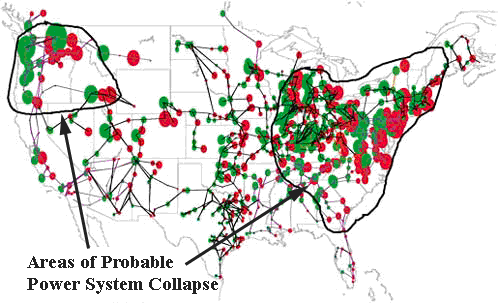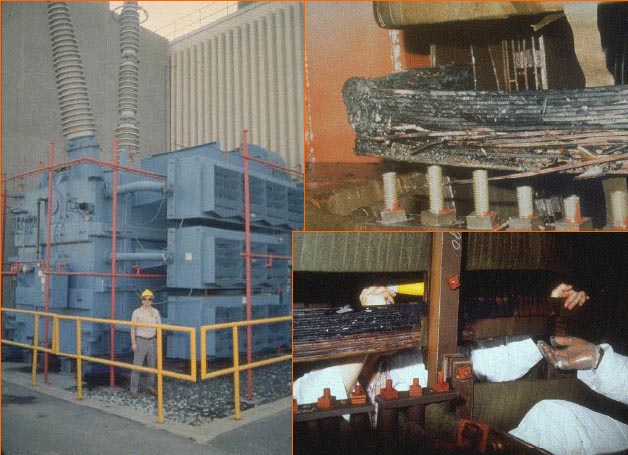Magnetic-Shield Cracks Found; Big Solar Storms Expected
Victoria Jaggard in San Francisco
National Geographic News
December 17, 2008

The magnetosphere normally blocks most of the solar wind
flowing outward from the sun. Currently an unexpected, thick layer of solar
particles inside the Earth's magnetic field suggests there are
huge breaches in our planet's solar defenses. Theses breaches indicate
that during the next period of high solar activity, due to start in 2012,
Earth will experience some of the worst solar storms seen in decades.
Solar winds also trigger storms that can interfere with
satelites' power sources, endanger spacewalkers, and even knock out
power grids on Earth. For full story >
http://news.nationalgeographic.com/news/2008/12
 A fiery coronal mass ejection (CME) took off from the Sun on Jan. 4, 2002
A fiery coronal mass ejection (CME) took off from the Sun on Jan. 4, 2002
The Great Storm: Solar Tempest of 1859
By Robert Roy Britt
Senior Science Writer
27 October 2003
In early September in 1859, telegraph wires suddenly shorted out in the United States and Europe, igniting widespread fires. Colorful aurora, normally visible only in polar regions, were seen as far south as Rome and Hawaii. "In 1859, the technology was quite low in comparison to today's technology," Bruce Tsurutani of NASA's Jet Propulsion Laboratory said. "However the technology that we rely on today is much more vulnerable." Damage is done, in part, by the solar storm inducing currents on power and communication lines, leading to potential overloads.
The charged particles can also zap satellites, as has occurred with handful of storms in recent years -- events with far fewer charged particles than in 1859. A space storm also heats the upper level of Earth's atmosphere, causing it to expand. That's no good for satellites that can get caught up in air that didn't used to be there. "This can lead to enhanced satellite drag and possible loss of these to the atmosphere," Tsurutani said.
The findings were published in a recent issue of the Journal of Geophysical Research For full story >
http://www.space.com/scienceastronomy/mystery_monday_031027.html
Top Geomagnetic Storm Events of Recorded History
 Locations of reported auroral observations during the first ~1.5 hours of the
September 2, 1859, magnetic storm (orange dots). Courtesy J.L. Green, NASA.
Locations of reported auroral observations during the first ~1.5 hours of the
September 2, 1859, magnetic storm (orange dots). Courtesy J.L. Green, NASA.
Magnetic observatories world-wide recorded disturbances in Earth's field so
extreme that magnetometer traces were driven off scale, and telegraph
networks experienced major disruptions and outages. A British amateur
astronomer, Richard Carrington, observed an outburst of "two patches of
intensely bright and white light" from a large and complex group of sunspots
the center of the Sun's disk the previous day, and so the solar storm of 1859
has been dubbed "the Carrington event". It remains the most severe solar storm
to affect the Earth in recorded history. For full story >
http://www.wunderground.com/blog/JeffMasters/comment.html?entrynum=1206
 Computer model study showing electrical systems that might be affected by
a geomagnetic storm equivalent to the May 14-15, 1921 event.
Computer model study showing electrical systems that might be affected by
a geomagnetic storm equivalent to the May 14-15, 1921 event.
The 1921 event wiped out telegraph service east of the Mississippi. The currents
induced in some telegraph wires were so strong that numerous fires were caused
and several operators were injured by exploding consoles. Radio reception was
completely lost in New Zealand, but was strengthened in Europe. Auroras were
seen as far south as Puerto Rico. For full story >
http://www.wunderground.com/blog/JeffMasters/comment.html?entrynum=1206
 The Salem nuclear plant transformer (exterior shot is one of three phases) and two images of internal heating damage to conductors
and insulation from stray flux heating caused by geomagnetically-induced currents from the March 13, 1989 Superstorm.
Image credit: John Kappenman, Metatech Corporation.
The Salem nuclear plant transformer (exterior shot is one of three phases) and two images of internal heating damage to conductors
and insulation from stray flux heating caused by geomagnetically-induced currents from the March 13, 1989 Superstorm.
Image credit: John Kappenman, Metatech Corporation.
During the March 13, 1989 Superstorm, geomagnetic-induced currents (GICs)
melted the internal windings of a 500kV transformer in the Salem Nuclear
plant in southern New Jersey. The entire nuclear plant was unable to
operate until this damaged transformer was replaced. Fortunately, a spare
from a canceled nuclear plant in Washington State was available, and the
Salem plant was able to reopen 40 days later. Had the spare not been available,
a new custom-built transformer would have been required, potentially idling the
power plant for years. The typical manufacture lead times for these transformers
are 12 months or more. For full story >
http://www.wunderground.com/blog/JeffMasters/comment.html?entrynum=1206



 A fiery coronal mass ejection (CME) took off from the Sun on Jan. 4, 2002
A fiery coronal mass ejection (CME) took off from the Sun on Jan. 4, 2002
 Locations of reported auroral observations during the first ~1.5 hours of the
September 2, 1859, magnetic storm (orange dots). Courtesy J.L. Green, NASA.
Locations of reported auroral observations during the first ~1.5 hours of the
September 2, 1859, magnetic storm (orange dots). Courtesy J.L. Green, NASA.
 Computer model study showing electrical systems that might be affected by
a geomagnetic storm equivalent to the May 14-15, 1921 event.
Computer model study showing electrical systems that might be affected by
a geomagnetic storm equivalent to the May 14-15, 1921 event.
 The Salem nuclear plant transformer (exterior shot is one of three phases) and two images of internal heating damage to conductors
and insulation from stray flux heating caused by geomagnetically-induced currents from the March 13, 1989 Superstorm.
The Salem nuclear plant transformer (exterior shot is one of three phases) and two images of internal heating damage to conductors
and insulation from stray flux heating caused by geomagnetically-induced currents from the March 13, 1989 Superstorm.